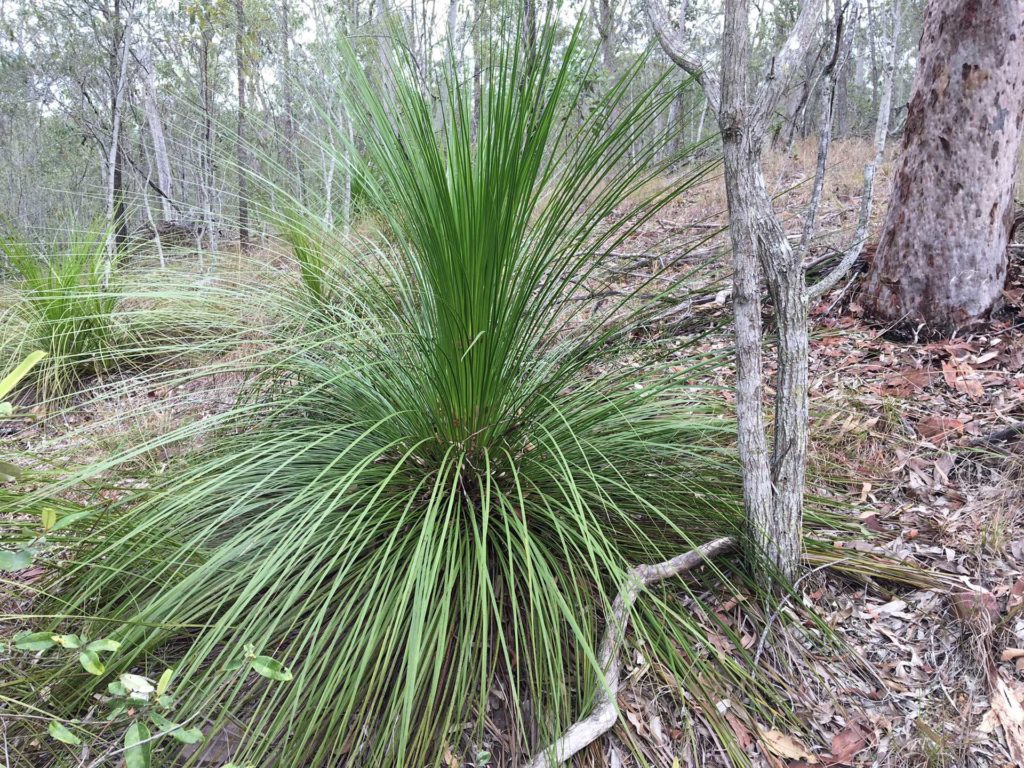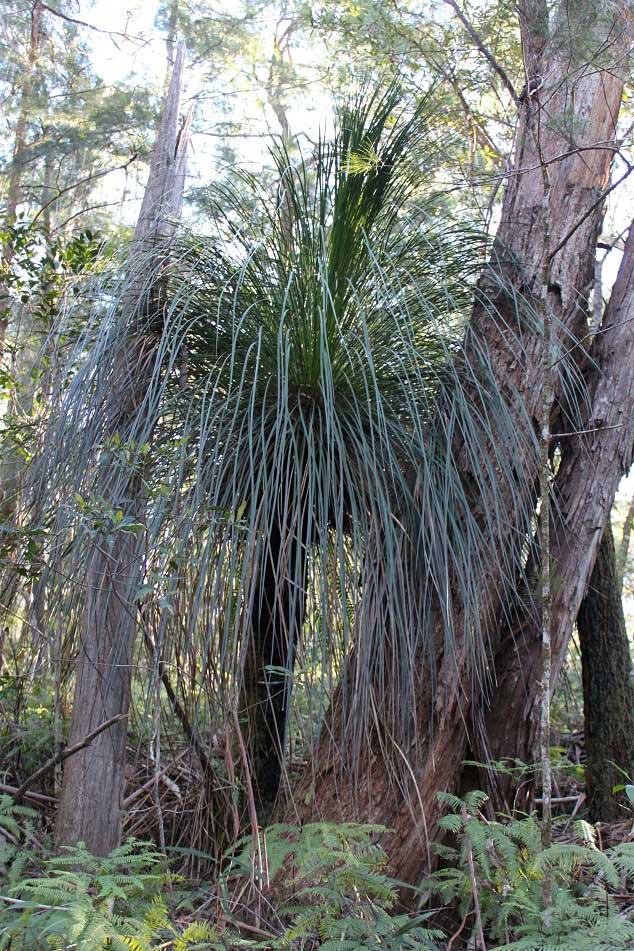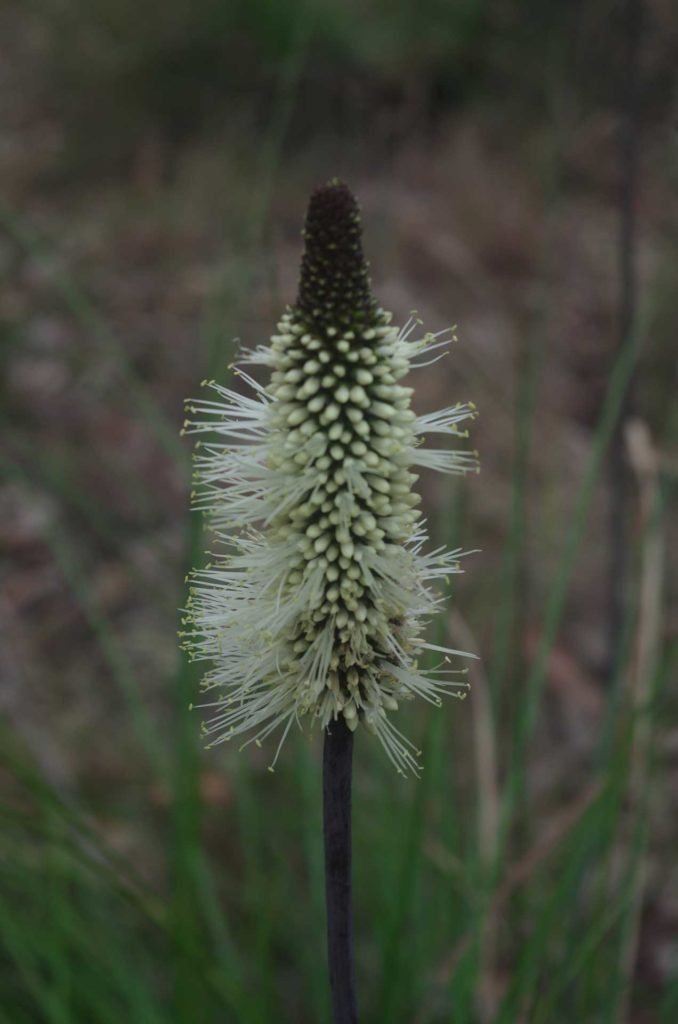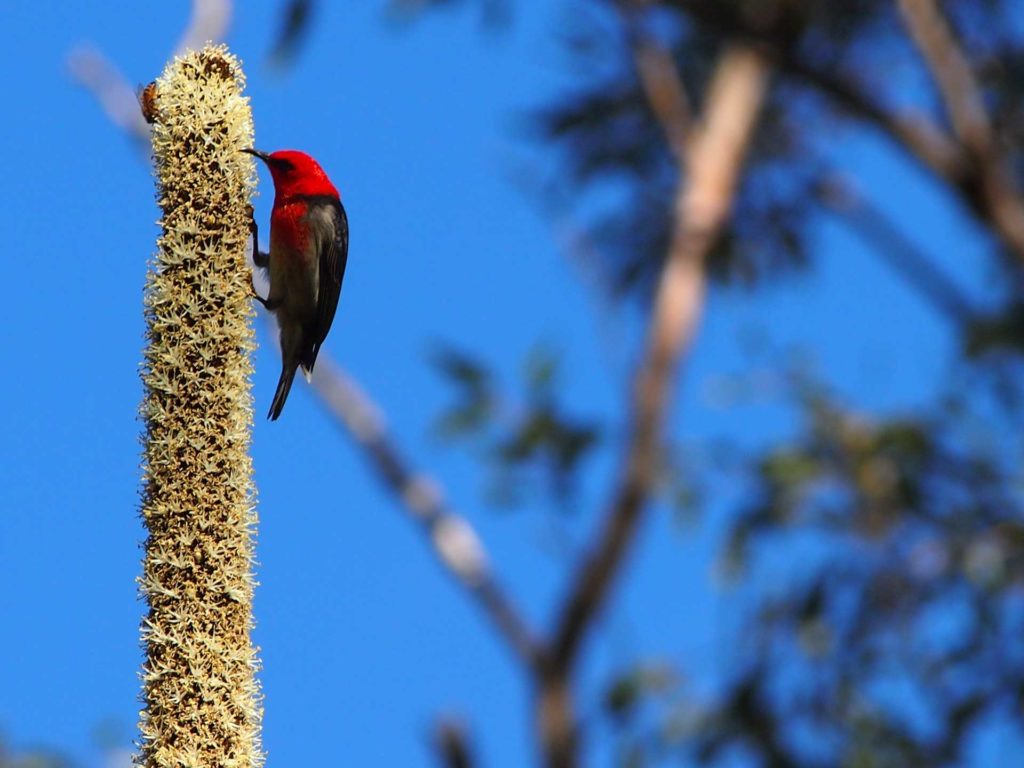Grass trees, belonging to the genera Xanthorrhoea, have a fascinating and unique biology and are some of the most distinctive plants in Australian flora.
Like all grasses, grass trees are actually monocots. ‘Monocot’ is short for monocotyledon, which refers to plants that have only one leaf arising from a germinating seed. In contrast, dicots, or dicotyledons, have two seed leaves. Other common monocots include bamboo, sugar cane, gingers, lillies, orchids and grains such as rice, wheat and corn.
However unlike other monocots, some Xanthorrhoea species have a tree-like form and can look as though they have a single or branched ‘trunk’. All grass trees have a fibrous root system typical of monocots that extends into the soil from the base of the leaves. The unusual roots are contractile (able to shrink) and the apex of plants can be 10cm below the ground surface. Even if it is a species of Xanthorrhoea that forms a trunk, the plant may exist as a ‘trunkless’ plant with just a rosette of leaves at ground level for up to 30 years before an above-ground trunk becomes visible.

The trunk is formed from accumulated old leaf bases, rings of secondary vascular bundles (plant tissues that transport nutrients and water), and resin that strengthens the stem. Nutrient transport is via aerial roots that run down the centre of the ‘trunk’.
Their ability to produce copious amounts of resin is a distinctive feature of Xanthorrhoeas. The word Xanthorrhoea comes from the Greek xanthos, meaning yellow, and rheo, meaning to flow, referring to the resin.
Grass trees are long-lived and slowgrowing. Research has shown that they can reach 250 years of age. An exception to this was a remarkably tall grass tree in southwestern Australia, which was six metres high and estimated to be 450 years old.
Xanthorrhoeas have an amazing resilience to fire as the living growth is shielded within the old, dead leaf bases of the trunk and the tightly packed moist young leaves protect the apex. Plants are highly flammable, burning quickly at high heat (up to 10000C). Many species of grass tree flower profusely after fire and are fertilised by the nutrients from the burnt leaf skirt.

and Lamington on rhyolite soils. Occasionally multi-trunked.
Leaves to 15mm wide. Very different to coastal X. latifola, which
is trunkless with leaves to 6mm wide. Photos by Glenn Leiper
Xanthorrhoeas provided a range of resources for indigenous Australians and early non-indigenous settlers. The resin was used like a hard-setting glue and waterproofing agent. A range of food was also provided by grass trees such as tender leaf bases, flour ground from the seeds, edible grubs, nectar from the flower stalks and honey extracted from bee’s nest within the grass tree.
Xanthorrhoeas also provide valuable wildlife habitat and are a source of food and shelter for a surprising diversity of animals and insects.
Xanthorrhoeas are an important source of nectar and seed for many bird and insect species, including Emus, cockatoos, rosellas, lorikeets and honeyeaters. Black cockatoos are known to rip open flower spikes to extricate beetle larvae. When in flower, the spear of the plant also attracts bees, ants and butterflies, which in turn attract insect-eating birds.

than 10% of the length of its stalk. It is a trunkless grass tree growing to
1m in eucalypt forests on coastal sands and ranges on moist rocky slopes.
In Brisbane, this species can be seen at Mt Gravatt Reserve and Karawatha
Forest. Photos by Liz Gould.
Many native bee species visit Xanthorrhoea flowers for pollen and nectar, but some species also make nests within the pithy stems of intact, old, dry flower stalks. One of these species is the Green Carpenter Bee (Xylocopa aeratus). Female Green Carpenter Bees hollow out the inside of flower stalks with their jaws, and then supply their eggs with small bundles of pollen and nectar.
The dense leaf skirts of grass trees are habitat for fairywrens, scrub-wrens, lizards and small mammals. Studies have shown that grass trees provide important nesting habitats for ground dwelling mammals such as the Yellowfooted Antechinus and the Common Dunnart.
According to Mangroves to Mountains (2008), there are five species of Xanthorrhoea growing in South East Queensland (SEQ), all of which are profiled briefly here (continued on page 8). Please note that X. latifolia subspecies maxima will be added to the new edition of Mangroves to Mountains, which is currently being worked on, and when released, will be reviewed in this newsletter.

and pollen from a grass tree flower spike.
Photo by Leanne Jackwitz.
References and Further Reading
Catterall CP & Wallace CJ (eds.) (1987) An Island in Suburbia: The natural
and social history of Toohey Forest. Griffith University. Fire & Biodiversity
Consortium (1999) Fire in Bushland Conservation.
Cox D, Glazebrook J, Leiper G & Rathie K (2008) Mangroves to Mountains: A
field guide to native plants of south-east Queensland. SGAP, Logan branch.
Garden JG, McAlpine CA, Possingham HP & Jones DN (2007) Habitat structure is more important than
vegetation composition for local-level management of native terrestrial reptile and small mammal
species living in urban remnants. Austral Ecology, 32:6.
www.anbg.gov.au
www.australiannativebees.com
www.birdlife.org.au
Article by Amanda Maggs
Land for Wildlife Officer
Brisbane City Council
